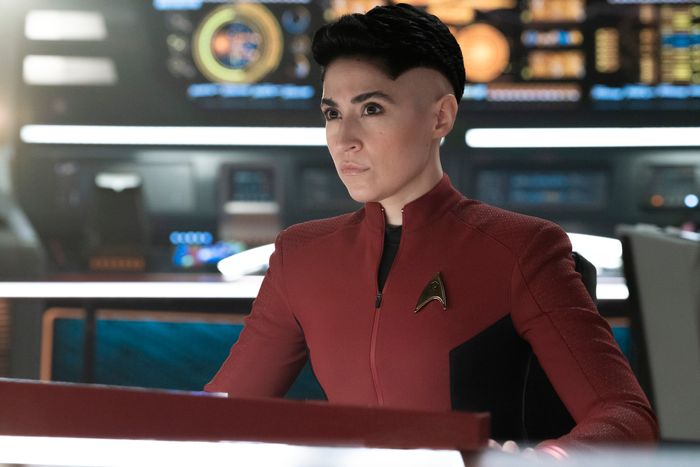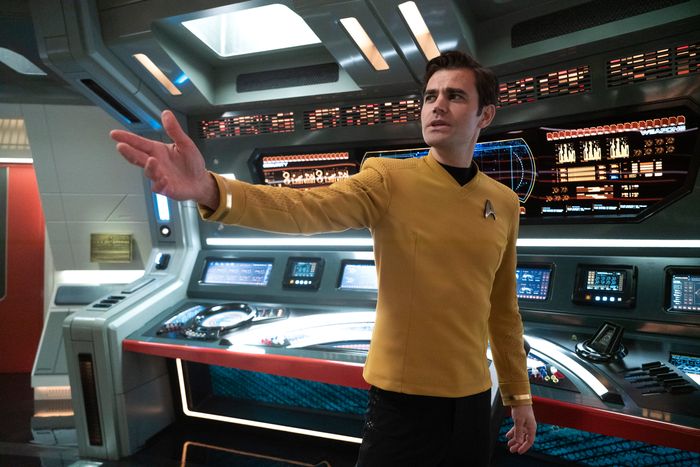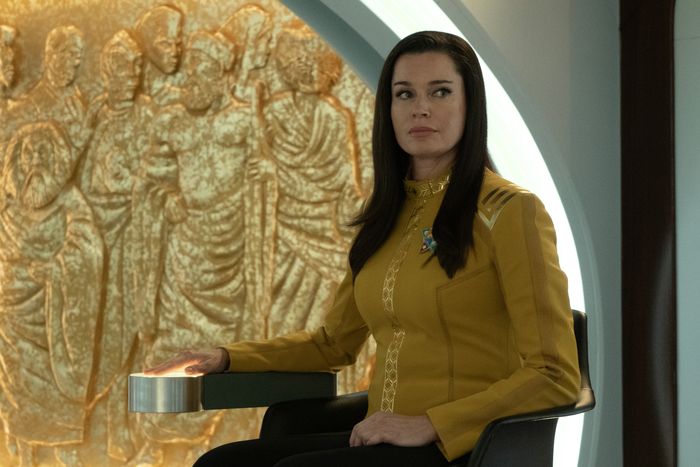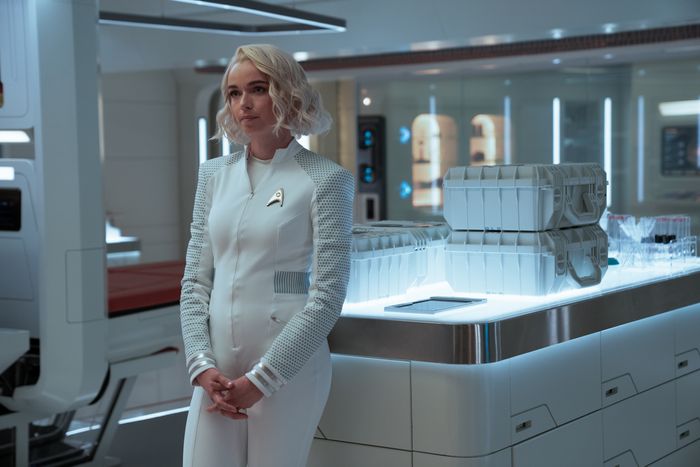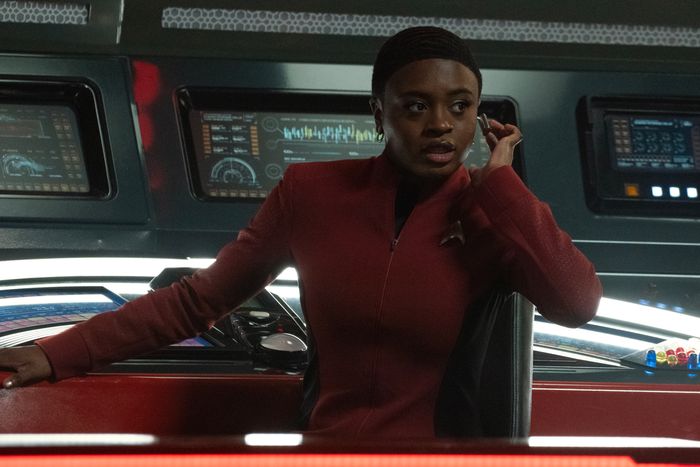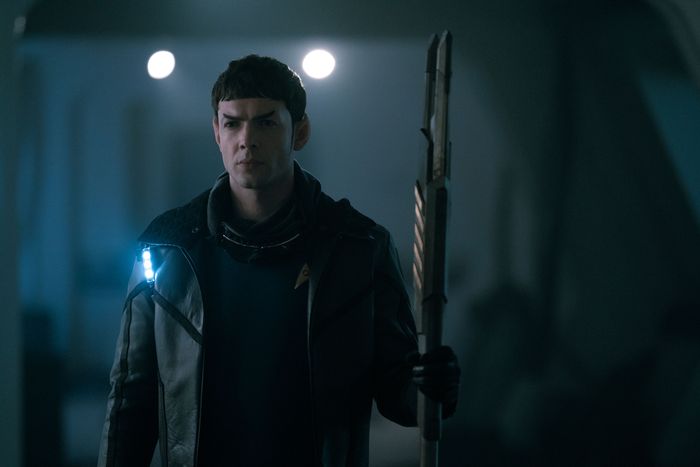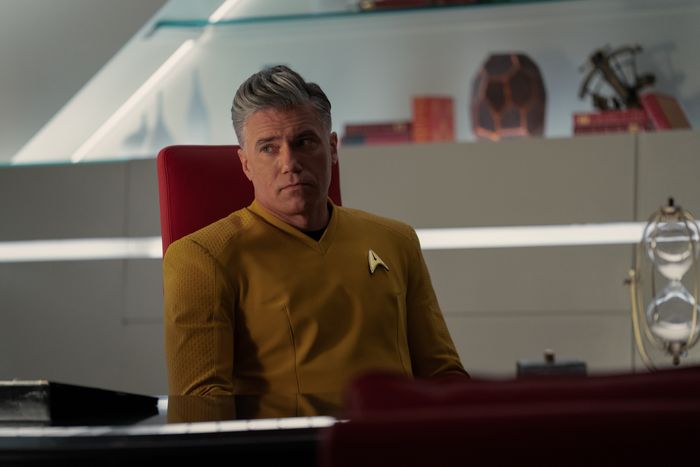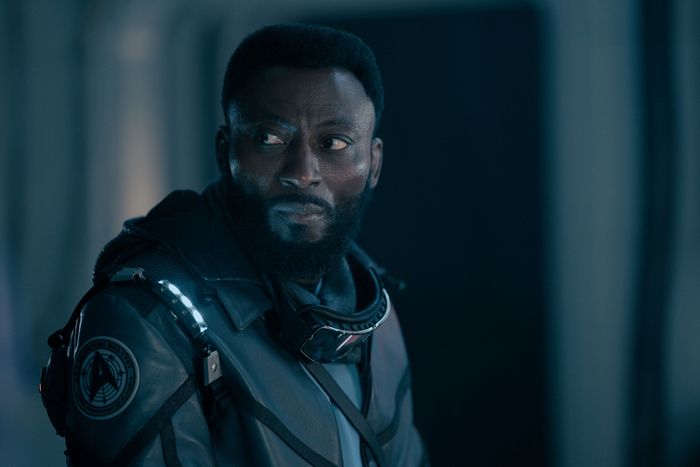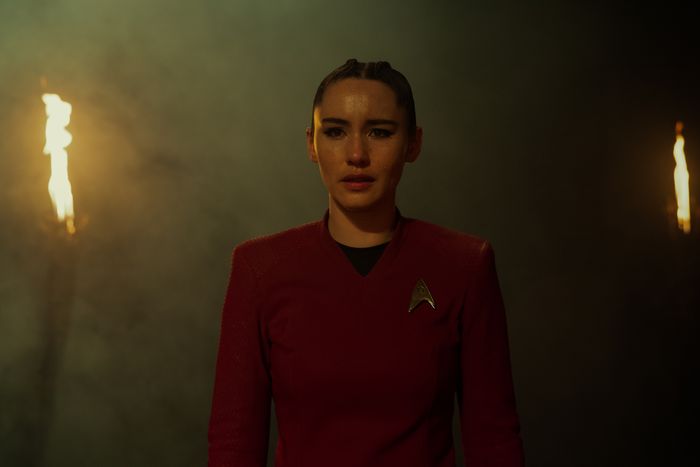
What a time to be alive: Fans of sci-fi and workplace shows have three solid Star Trek spinoffs to enjoy. Strange New Worlds is wrapping up its second season, Lower Decks is slated to return for season four in September, and Discovery will be back for its fifth and final season in 2024. Strange New Worlds in particular is such fun to watch, reveling in the freedom of episodic storytelling to explore a bunch of different genres and tropes including body-swapping, being trapped in a fairy tale, and, most recently, boldly going right to an unlikely, delightful musical reality. But the fun of watching the crew of the U.S.S. Enterprise week to week can obscure how much sadness and grief they’re all carrying around. From First Officer Una Chin-Riley being forced to hide her Illyrian identity on pain of being expelled from Starfleet to Spock’s surprisingly emotionally tortured logic, this crew needs a hug.
Of course, the various buried traumas that none of them want to acknowledge is at the heart of what makes Strange New Worlds tick; it’s so much easier for this crew to develop aspirationally rich work relationships than to confide in one another about their painful pasts. But the truth will out, as we saw in musical episode “Subspace Rhapsody,” and as awkward as it is to have all your messy emotional stuff out there like so much space junk, it’s also freeing. As the second season concludes on a whopper of a cliffhanger, let’s assess who’s the saddest of them all, from the least burdened to the gloomiest Gus.
10.
Erica Ortegas, Helmsman
Is she sad? More righteously furious than sad, but only on occasion.
Okay, why? Put it down to her service in the Klingon War. In the Strange New Worlds continuity, that conflict ended a few years ago, and although everyone serving on the U.S.S. Enterprise is far safer than they were during the war, those feelings can and will erupt from time to time, such as when former Klingon general/current peace negotiator Rah pays a visit in “Under the Cloak of War.”
How she’s hiding her fury: Ortegas isn’t so much hiding her feelings as focusing on other things, such as spectacularly daring flying and being a supportive friend to Nurse Christine Chapel.
9.
James T. Kirk
Is he sad? Not exactly.
Okay, what does that mean? In “Subspace Rhapsody,” the U.S.S. Farragut’s new No. 1 describes himself to La’an Noonien-Singh as having a complicated life. Complicated is messy, but it’s not quite the same as being sad.
How he’s hiding his sadness, or whatever complicated emotion it is: Future Enterprise Captain Kirk is famously breezy. Often infuriatingly so, especially if you are his future long-suffering bestie, Mr. Spock. He’s not incapable of seriousness, though. In “Subspace Rhapsody,” Kirk felt some genuine pangs when explaining to La’an that he and his on-again, off-again partner, Carol Marcus, are expecting a baby. In the same scene, he also grieved a bit for an alternate reality he doesn’t remember, in which he and La’an caught feelings for each other. He was murdered in that reality, but lacking any memory of it, Jim doesn’t have to drag that particular sadness around with him the way La’an does.
8.
Una Chin-Riley, First Officer
Is she sad? She’s emerging from a decades-long crushing sadness and fear of discovery. Progress!
Why is she sad? Being part of an ethnic minority barred from Starfleet service and forced to hide a crucial aspect of her identity? That’s pretty tragic! By rights, Una has reason to be even sadder than she is. The ordeal of facing legal and professional consequences for having the gall to serve the galaxy as a genetically modified Illyrian was bad enough. Knowing that the treasured home and found family she’s built over the course of a sterling career could have been snatched away from her on outdated and bigoted grounds would enrage a lesser person (it’s me; I’m the enraged lesser person).
How is she hiding her sadness? As will soon start to sound like a broken record, Una’s first and favorite method is unfailing professionalism and commitment to her job. As she counsels La’an later in “Keeping Secrets,” being her own best friend and confidante has worked in the past, but she can see now that “it doesn’t serve me anymore.” The hopefulness of her charming waltz duet with Kirk, “Connect to Your Truth,” suggests that a somewhat more vulnerable and authentic approach will suit her better.
7.
Nurse Christine Chapel
Is she sad? Sadder than you might imagine.
Why is she sad? Christine has an intense combo pack of PTSD from her service in the Klingon War and an acute case of the common heartache affliction first described by the great 20th-century pop diagnostician Dr. Sting as “If You Love Someone, Set Them Free”–itis. Cautioned by one of the Below Decks visitors that in their future, Spock is definitely not a smiley, good-time-Charlie kind of guy, Christine breaks up with him to make sure their love doesn’t get in the way of his attaining his destiny as a great man of their age.
How is she hiding her sadness? Christine is usually pretty carefree and easy-breezy in a way that is never grating, which covers a lot of ground. It’s worth noting that even in her big ensemble number, “I’m Ready,” she frames her inner conflict as a matter of ambition versus romance. Like Una, she’s very good at keeping secrets. I’m curious as to the fate of her fellowship (and her fate, in general) following the season finale’s massive cliffhanger.
6.
Commander Pelia, Head of Engineering
Is she sad? Absolutely.
Why is she sad? Pelia is a nearly immortal Lanthanite, she’s a genius, and she has magnificent hair – what’s to be sad about? Well, as any vampire can tell you, immortality sucks, actually! Knowing you have centuries, or even millennia, ahead of you while you watch your friends and loved ones age, wither, and die is enough to trigger a long-term existential crisis in anyone. Here’s hoping season three will tackle this aspect of Pelia’s character in more depth.
How is she hiding her sadness? Pelia is another character married to her work. That’s treacherous emotional ground, though, because she’s taken over as head of engineering from the late, lamented Hemmer, who was one of her best students from her teaching days at Starfleet Academy. It’s hard to say to what degree Pelia’s puckish sense of humor is rooted in melancholy, her self-proclaimed aversion to boredom, or innate exuberance, but it certainly contributes to her slight air of daffiness, which is also a helpful uncomfortable-emotions-deflection tool. The arrival of Montgomery Scott looks like it’ll prompt some very funny moments next season — funny for viewers, at least. Scott and Pelia have a history of grinding each other’s gears, but here’s hoping having two engineering geniuses on the crew will yield more than just conflict.
5.
Nyota Uhura, Communications Officer
Is she sad? Sure is.
Why is she sad? Captain Pike calls Ensign Uhura the Voice of the Enterprise. She’s very unassuming, but it’s an apt moniker for the ship’s hypercompetent communications officer. Uhura’s sadness has many layers; she joined Starfleet to take her mind off the tragic deaths of her parents and brother in a shuttle crash, and her grouchy yet wonderful mentor, Chief Engineer Hemmer, sacrificed his own life at the end of last season to save the rest of the crew.
How does she hide her sadness? Uhura is the youngest crew member by far, something her colleagues tend to lose sight of because she’s so capable and eager to learn. Uhura’s sunniness and desire to help others are both sincere, giving her huge “a pleasure to have in class” energy, a very powerful mask for complicated feelings.
4.
Mr. Spock, Science Officer
Is he sad? Look up “emotionally tortured” in your handy Oxford Illustrated Dictionary of Feelings and you’ll see this guy’s face.
Why is he sad? Feeling insufficiently human and insufficiently Vulcan, combined with the isolation of having zero peers who share his multi-species identity, has done a number on Spock. He cares deeply for Nurse Chapel — they’ve got a genuine friends-to-lovers thing going on, and I am here for that particular trope — but she’s broken things off with him, ostensibly to pursue a really cool-sounding three-month fellowship in archaeological medicine, and he feels like a chump. It was risky to lean into his humanity by not relying on rigorous Vulcan logic to keep those outsize feelings in check, and now he’s paying the price of being plunged into a very emo place.
How is he hiding his sadness? Logic to the rescue! And throwing himself into his work! Singing his way through it in “Subspace Rhapsody” was probably helpful, but let’s not forget, Christine broke up with him in front of a huge crowd who was singing and dancing right along with her. That’s gotta sting with the pain of an entire hornet’s nest. But his underlying affection and collegial concern for her can’t be logic-ed away, and that’s all to the good, as it leads to them rescuing each other from the wreckage of the U.S.S. Cayuga following a massive Gorn attack in the second-season finale. That hand-holding as they watch the wreckage of the Cayuga hurtle away can’t mean nothing.
3.
Captain Christopher Pike
Is he sad? You might think that being space’s greatest silver fox would be an unbreachable bulwark against melancholy, but you’d be wrong.
Why is he sad? Everyone’s favorite Space Dad knows he’s going to die in order to save others (especially Spock, who has a very big future ahead of him) and has accepted this fate with grace. That doesn’t mean it’s not a far-out bummer! Perhaps even worse, his beloved Captain Batel is incubating Gorn eggs, and the window to save her is swiftly closing. The season finale ending on an image of his anguished face suggests he may be deep into it’s-better-to-have-loved-and-lost territory by the end of the third-season premiere.
How does he hide it? On a ship of workaholics, Pike is a good role model for maintaining outside interests. Feeding the people he leads and loves with delicious quarters-cooked meals is Chris’s love language, and absent that outlet, he would probably go entirely off the rails. It’s a classic — and delicious! — avoidance strategy that’s got to fail at some point.
2.
Dr. Joseph M’Benga, Chief Medical Officer
Is he sad? Dr. M’Benga is very, very sad.
Why is he sad? When M’Benga’s daughter, Rukiya, developed a rare, incurable (fictional) disease, cygnokemia, he bought them both some time by suspending her in the pattern buffer of the medical transporter in the Enterprise sick bay. In “Under the Cloak of War,” we see that this on-the-fly emergency-medicine strategy is one he’s had up his sleeve since at least the Klingon War — he uses it to keep a critical patient alive while his and Nurse Chapel’s field hospital is under attack. His attempts to discover or develop a cure were to no avail, and he eventually agreed to let go of his dream of a cure, sending Rukiya’s consciousness to live in incorporeal form in a nebula at the end of season-one episode “The Elysian Kingdom.” Weep, weep. Also, he has PTSD from his experiences as a very effective special-ops assassin in the Klingon War. He’s got a lot going on!
How is he hiding his sadness? Like many of his fellow sadsters in Starfleet, M’Benga focuses pretty ruthlessly on work, pouring his free-floating care for others and his own grief into helping his patients. He’s also an A+ friend and mentor to Nurse Chapel and a skilled martial artist. “Under the Cloak of War” is reminiscent of the more serious episodes of M*A*S*H, making me think it would be a good idea for Starfleet Command to establish a corps of psychological health officers to make the rounds of the fleet to check in on and treat Klingon War veterans. Wouldn’t a Sidney Freedman–type character fit nicely into this ensemble?
1.
La’an Noonien-Singh, Chief of Security
Is she sad? Oh, my, yes. This poor woman is the saddest tough cookie.
Why is she sad? How much time do you have? First of all, she’s her family’s sole survivor of a gruesome attack by the Gorn. All she has left of her parents and brother are her memories and her surname, but even that’s a source of terrible pain, grief, and shame. To be a Noonien-Singh is to walk around with a big flashing sign reading “DESCENDENT OF A TYRANNICAL EUGENICIST MANIAC” over her head. Not unrelatedly, she’s also been dragging her own heart around since meeting, falling for, and losing Jim Kirk in the alternate-timeline episode “Tomorrow and Tomorrow and Tomorrow.” Her pain has been multiplied and basically unprocessed because the laws of wibbly-wobbly timey-wimey stuff prevent her from speaking of it to a single creature.
How does she hide her sadness? Excruciating professionalism and reserved decorum to the rescue! She’s got an “Elinor Dashwood in Space” routine down to a science — basically, Be Like Una, Only More So — but as she learned through her big solo ballad, “How Would That Feel,” and then through the sisterly advice of Una’s “Keeping Secrets” in “Subspace Rhapsody,” that can only take her so far. Christina Chong, who plays La’an with such sensitivity, remarked in a recent episode of “The Ready Room” that viewers can expect to see a somewhat changed La’an going forward. She has more than earned some carefree times, and to see her take a chance or two — for romance, or just for fun, because she can — would be such a refreshing and heartwarming treat after the intense suffering of the last two seasons.


